
This Is Your Sign to Rip out Your Concrete Backyard and Turn It into a Lush Retreat
It’s time to ditch the hardscaping. The design team at Peruse turns a concrete-heavy plot into a chic retreat.
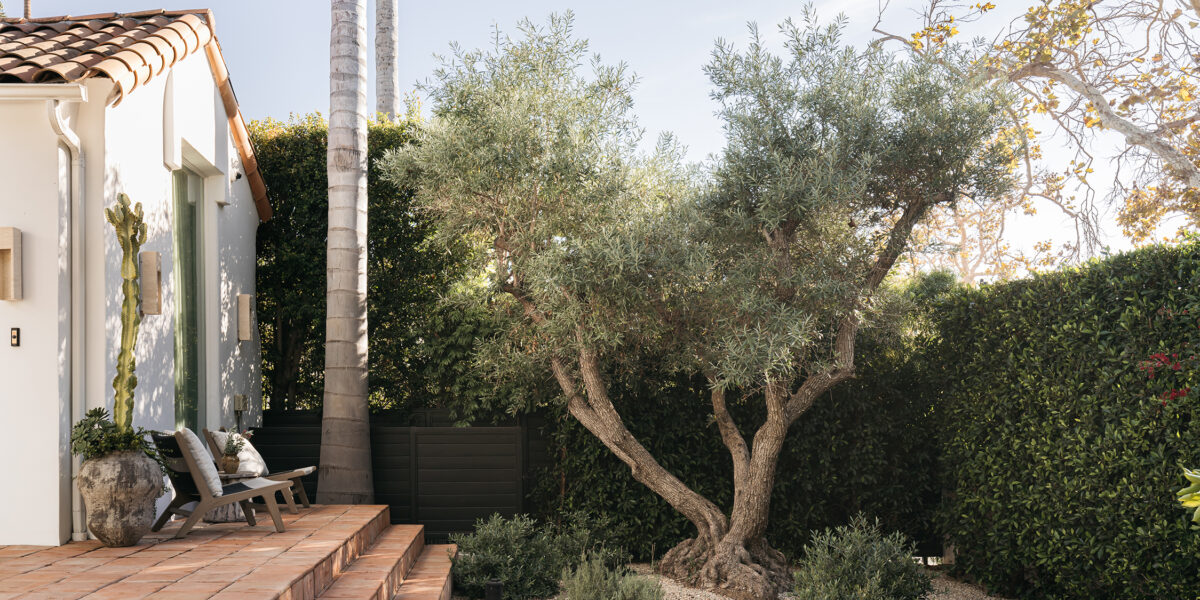
Overly paved landscapes are unfortunately common here in the West, with many homes wrapped in long driveways that continue into backyards and coat the entire area with concrete. Not only does hardscape cause damage to topsoil, it also raises environmental temperatures with the ability to absorb as much as 95% of the sun’s energy, which is then radiated back into the surrounding atmosphere. While large areas of pavement were once an affordable, low-maintenance option, it’s in our best interest to remove and replace them with more sustainable options. Yes, tearing out existing hardscaping seems like an intimidating task, but creating a more permeable landscape to catch water runoff and introducing location-appropriate plants can increase health benefits not only for yourself, but the ecosystem around you.
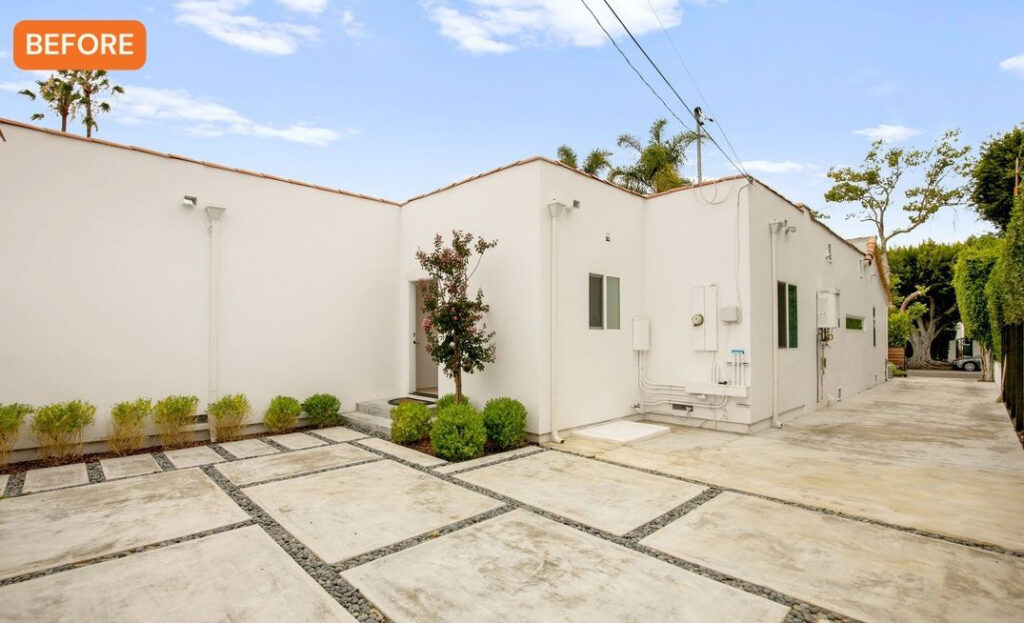
Courtesy of Peruse Studio
The design team at Los Angeles-based Peruse Studio are no strangers to creating beautiful, well-functioning gardens that thrive over time and their recent project just off Melrose Place is proof that pounding out the pavement has great rewards. This once-sterile, cement-heavy backyard is now a lushly layered hideaway that offers privacy and a quiet retreat from the busy city. Founders Mintee Kalra and Patrick Lord break down the process and all the design details that make this space a haute hangout where absolutely no one misses the hardscape.
Creating a Semi-Permeable Paradise
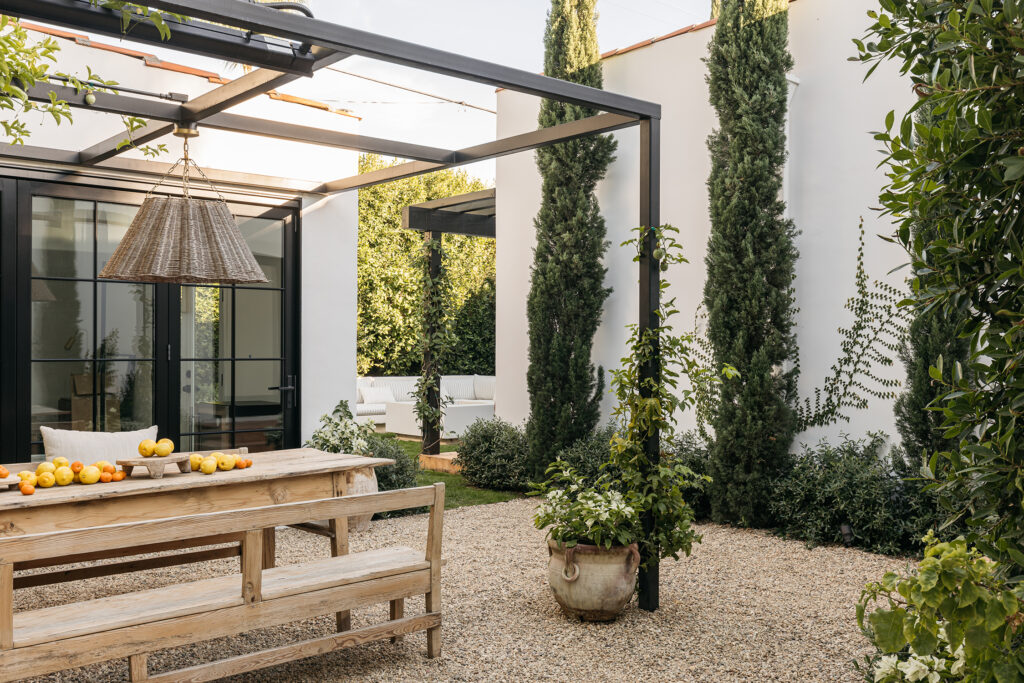
Christopher Lee Foto
It’s time to bring in the jackhammers and a licensed crew to properly dispose of or recycle that concrete. Peruse replaced the large pavers and slabs of cement with 3/8 Del Rio pea gravel which was contained with metal edging, creating a flat, even surface, perfect for high-foot-traffic areas. Not only is pea gravel a more cost-effective option compared to concrete or asphalt, it also allows rainwater to collect and drain without any pooling while properly absorbing back into the ground, recharging neighboring plants. This material also provides a softer texture and transition into plantings while still defining specific areas for entertaining.
Planting for Privacy
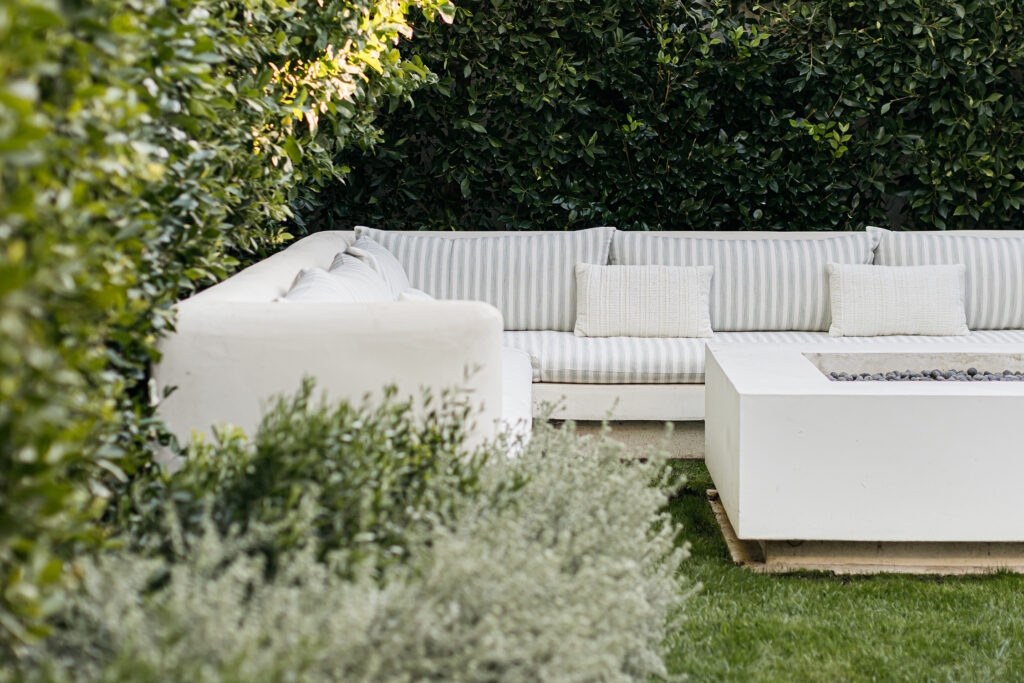
Christopher Lee Foto
Enclosing the property from as much exterior visual noise as possible was the main goal for this particular garden. The team started with an intentional color palette and identified which plants would provide the base green tones. From there, an intentional layering of more washed-out gray-green tones, a sprinkling of “optimistic limey green,” and deeper evergreens not only created a thick foliage layer for privacy, but also muted out the surrounding city hum. The final plant selection was 75% evergreen with the remaining 25% deciduous plants with their bloom times spread across the four seasons so that the garden is constantly changing and adapting to the climate. While a Mediterranean plant palette is the center stage for this particular garden, the team at Peruse advises, “It is incumbent upon us to approach each decision with sensitivity to resources.” They prioritized both plants and trees with low-water needs as well as efficient drainage in hardscape treatments, which they tailor to the local ecosystem to provide habitats and pollen sources for the native pollinator populations.
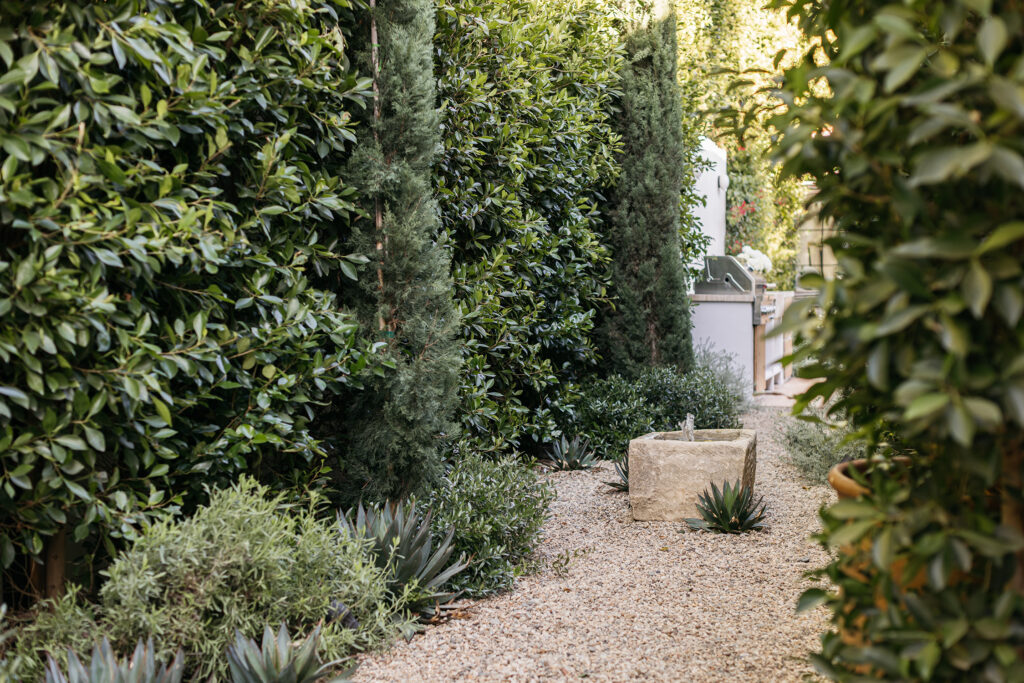
Christopher Lee Foto
The long narrow passageway where the driveway once continued into the backyard was the biggest opportunity for transformation through plantings. Laurel fig (Ficus retusa nitida, F. maicrocarpa) and waxleaf privet (Ligustrum japonicum ‘texanum’) provide the bulk of the outer boundary and privacy height, while Italian Cypress (Cupressus sempervirens) was added in a broken repetition to draw the eye vertically and elongate the space. A tapestry of little Ollie (Olea europaea), smokey westringia (Westringia fruticosa ‘smokey’), and sweet lavender (Lavandula heterophylla) were then woven together in curvature to keep the eye moving with agave blue glow (Agave x blue glow) dotted throughout for a pop of color. Peruse proves here that even small areas can handle a large selection of dense plantings, which in turn make the area feel more spacious and inviting, especially when intentional color and leaf texture are layered correctly.
Redefining Rooms
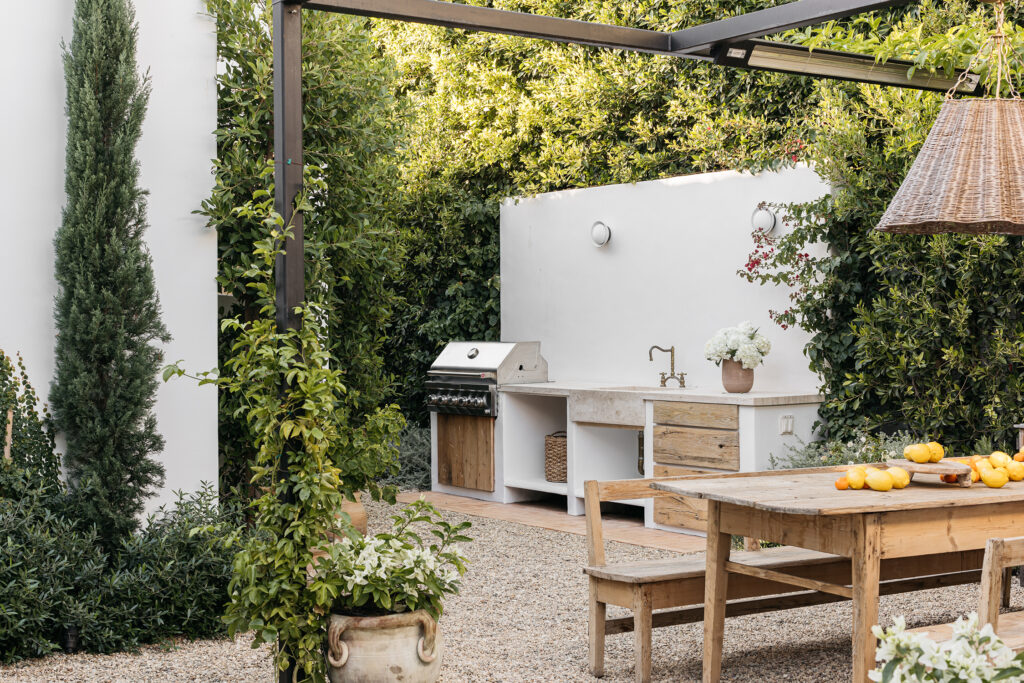
Christopher Lee Foto
When it comes to creating exceptional outdoor rooms, Peruse encourages one to be meticulous with sun pattern studies and observe where light is abundant during those hours. Ask yourself where will you be cooking, entertaining or just lounging with a book. For this garden, the dining experience was a focal point and intended to be enjoyed from late afternoon through dusk. The team integrated dappled light by softening the open steel frame trellis with plantings of passionfruit (Passiflora edulis) and honeysuckle (lonicera semperviren).
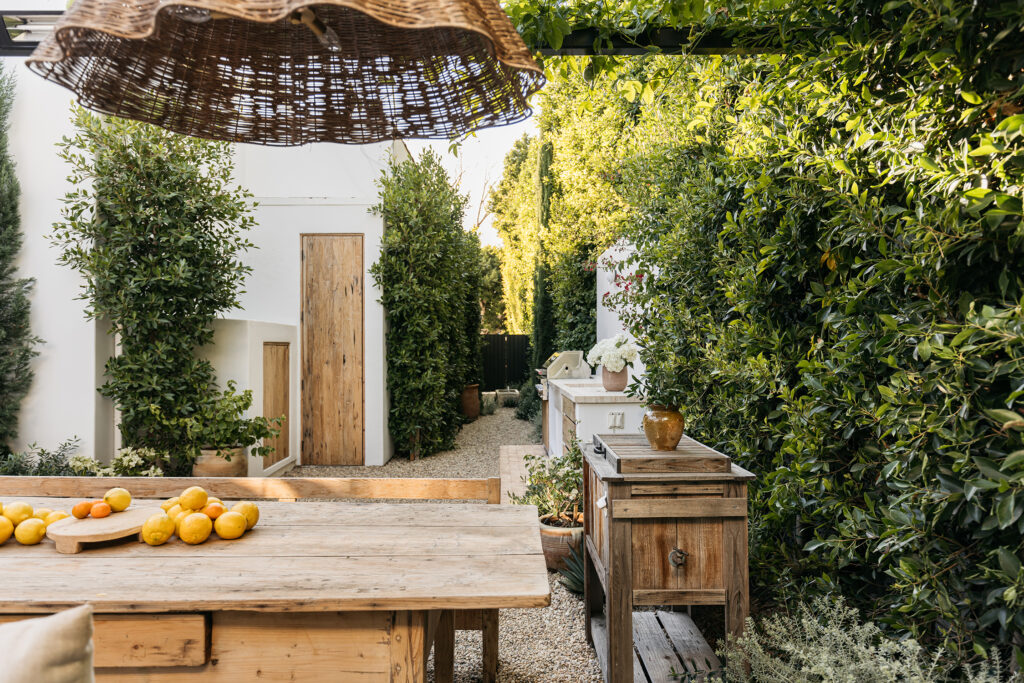
Christopher Lee Foto
Mintee Kalra recommends using treasured objects as a touchpoint for outdoor living rooms and design direction. Here, an antique Provencal farmhouse dining table acted as inspiration—an old-world patina wood story is woven throughout the space. Reclaimed white oak in varying widths of wide plank was used in the outdoor kitchen and storage areas. Unexpected design details such as mitered-edge finger pulls, antique wooden mortars from India, and a reclaimed Chinese bench from an 18th-century barn fill the outdoor area. This mixture of rustic wood keeps the design from feeling too precious while weaving in additional organic textures into the entertaining spaces.
Cohesiveness Through Containers
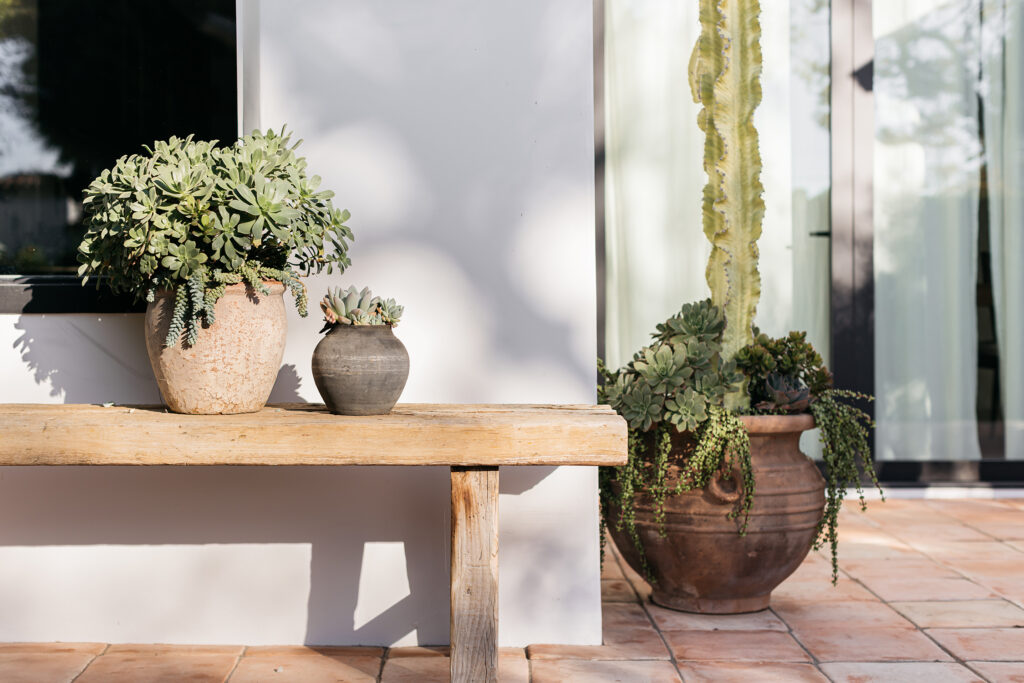
Christopher Lee Foto
To top off the design, the use of multiple planters in various sizes is a creative way to continue the design narrative throughout the garden. The Peruse team used rounded vessels such as Moroccan olive jars, Mexican ribbed planters, and Greek pitho planters, which have earthy finishes creating looks like buffed terracotta, glazed ceramics, limewash, and hand-chiseled limestone, which add additional old-world character throughout the space. Similar plantings and color stories are then extended out from the border plants—a perfect example of how the use of containers to continue landscaping into smaller areas such as patios, tabletops, and corners is the perfect solution when in-ground plantings are not possible.
